For 160 years we have been posting our mail into pillar, wall and lamp boxes, but how many of us actually look at the box in which we post our mail? Do we pay attention to the royal ciphers that denote the age of the box? Or know the impact of momentous historical events that directly affect the letter boxes on our streets? Post boxes, a part of everyday life for most of us, are un-loved, under-used in the digital age and have a fascinating history of their own.
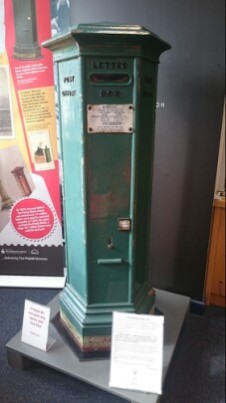
Initially British post boxes were painted green but in 1874 the standard bright red colour was chosen to aid visibility, as some people complained that the green pillar boxes were difficult to find.
Only post boxes of special interest are normally allowed to divert from the red body with the black base. The one below with ‘post office’ painted in gold is in a prime tourist location near Windsor and its VR cipher (unseen in this image), indicating Victoria Regina, is a clue to its age. Some of the early post boxes have now received Grade II listed status which affords them some protection over removal or re-siting. Grade II listed hexagonal ‘Penfold’ pillar boxes, named after John Penfold who designed them, are ‘almost always listable’ due to their scarcity. Historic England and the Royal Mail, with the approval of the Department for Culture, Media and Sport, have agreed a joint policy for the retention and conservation of all operating letter boxes at their existing locations, unless ‘exceptional circumstances necessitate their removal.’
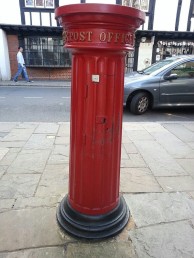
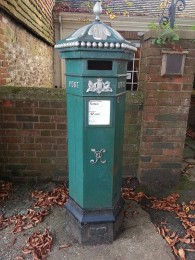
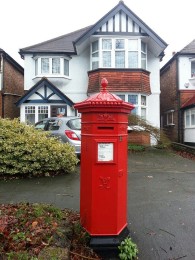
Novelist Anthony Trollope, when working for the General Post Office (forerunner of the Royal Mail), first introduced the pillar box in Jersey and Guernsey in 1852, with the British mainland pillar box following in 1853. Letter boxes were built to local specifications but by 1859 a standardised cylindrical pillar box was introduced. Further types of post box followed: wall (1857), usually fixed inside a brick wall or gate-post, Ludlow (1885), used at sub-post offices and the lamp box (1897), usually attached to a lamp post and most often in rural areas. Approximately 350 post box designs are recorded, although most are a variation on a theme. Necessary modifications were made to the aperture, or mouth of the letter box, as the service progressed. Early Victorian boxes had vertical apertures; however the horizontal aperture became standard and rather than remain in the body of the pillar box, it was moved to the door to prevent letters getting stuck in the roof of the box. The aperture was also covered with a shade to prevent rain water damaging the mail.
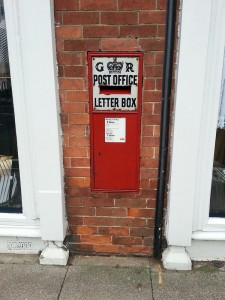
The standardised cylindrical box did not suit all. The ‘Liverpool Special’ was designed in 1862 when it was noted that particularly busy post boxes in Liverpool were almost overflowing with mail. The Liverpool postmaster lobbied the General Post Office for a bespoke letter box, better suited to the newspapers and other large packages that were regularly posted in the city. The design remained cylindrical, but had a larger aperture with the words ‘Post Office’ framed by nautical rope detailing. It omitted the VR cipher; however it was topped with a large crown. By 1863, seven Liverpool Specials had been cast and placed around the city. The last remaining functional Liverpool Special can be seen in its re-sited position at the Albert Dock.

Edward VIII and his short reign
In January 1936, the Post Office Circular assured the new King Edward VIII of ‘their continued loyalty and devotion.’ However, the King could not offer his subjects the same guarantee and his reign lasted just 325 days. Accordingly, the post boxes bearing his royal cipher are the rarest. Out of the 271 letter boxes cast in 1936, 161 were pillar boxes, the remainder being wall, lamp and Ludlow boxes. The placement of the first post box bearing the cipher of Edward VIII at Balmoral was announced in The Times on September 11 1936. Less than 150 of these post boxes remain. Significantly, the abdication resulted in a series of letters and memorandums between the Director of Postal Services and the Stores Department during the autumn and winter of 1937, displaying official concern that the abdication crisis, had, or would affect, a governmental department.
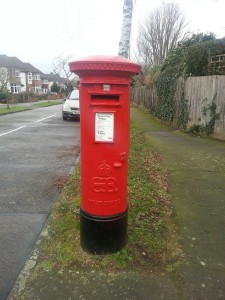
A distribution list of post boxes bearing the former monarch’s cipher was requested by the Postal Department. On examination Glasgow was considered ‘unlucky’ to have twenty-seven boxes bearing Edward VIII’s monogram, Manchester followed next with seven. The uneven distribution of pillar boxes to Glasgow during 1936 was not explained. It was noted that when sent for repair, boxes bearing the cipher of Edward VIII were to be quietly exchanged with George VI monogrammed boxes or the doors replaced with the new king’s cipher. The cost of changing the cipher in situ for the Ludlow type box was priced at £9.15s for each box, with a total of twenty-eight boxes needing amending. This was to be done as ‘unobtrusively as possible’ and when ‘considered desirable’ to avoid any embarrassment to the General Post Office or to the new monarch.
A second Liz?
Our present Queen’s cipher also had to be removed from pillar boxes, but rather than scandal, constitutional exactitude was the reason. After Queen Elizabeth II ascended the throne, her cipher of EIIR was produced on pillar boxes. Scottish Nationalists vociferously campaigned for the royal cipher to change as there never had been a Queen Elizabeth I of Scotland. A Scottish republican song at the time bore the line, ‘How can you have a second Liz when the first yin’s never been?’
Pillar boxes were targeted as they bore the symbolic royal insignia that pronounced English rule over Scotland. The first EIIR monogrammed pillar box was situated at The Inch, in Edinburgh. From its erection in November 1952, it was tarred and feathered, smeared with paint, set on fire, had incendiaries placed inside (which failed to ignite), attacked with a 7lb hammer and finally blown up by gelignite in February 1953. It was suspected, but never proven, that the Scottish Republican Army was responsible for the bombing. The national committee of the Scottish Covenant Association passed a resolution regretting that violence might ensue in Scotland but condemned the ‘obstinacy’ that the authorities had shown in keeping the offending numerals in the royal cipher. The SCA called on the Secretary of State to guarantee that a replacement pillar box at The Inch, or anywhere else in Scotland, would not incite further violence with the numerically incorrect cipher. The original pillar box was replaced by one without a royal cipher. However, Scottish nationalists had previously failed to address that there had never been a Scottish Edward VII or Edward VIII and the pillar boxes adorned with their ciphers were not affected by the protests. The 1952-53 campaign gained the successful removal of the royal cipher from the newly installed EIIR Scottish post boxes and the insertion of a Scottish crown.
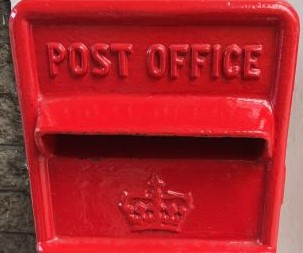

The ‘Belfast Box’
The Irish Postal Service broke away from the GPO in 1922 when Southern Ireland became independent of Britain. British pillar boxes were repainted green, although British royal ciphers remained on the pillar box from the time of installation. This occasionally ignited further protests from Irish militants.
Like the Scottish nationalists, militant Irish rebels also used post boxes as weapons of war during the twentieth century. From the 1920s the royal monogram was removed from damaged boxes before reissuing after repair to reduce the likelihood of a repeat attack on the emblem of British sovereignty on Irish soil.
Later in the twentieth century, the Irish Republican Army would paint pillar boxes in Northern Ireland green as a protest against British rule. As ‘The Troubles’ worsened it became necessary to limit the aperture of the box to a strictly minimal opening to prevent the insertion of bombs. These boxes became known as ‘Belfast boxes’. Post boxes were modified in Northern Ireland and on the mainland.
Post boxes as symbols of Crown and State have endured through all the changes of the political climate. They have been a constant presence in British society for over one hundred and sixty years. They are the working embodiment of communication history. The sheer number of them make them the targets of rebellions, but also, they reflect the stability of the country, the monarchy and our national identity. Many momentous historical events have impacted the existence of the post box. We may ignore such a humble street structure but the iconic status of the British post box ensures that it will remain on our streets for some time to come.
To read more about Victorian fluted pillar boxes click here.
To read more about Suffragettes and the post click here.
To read more about royal ciphers on post boxes click here.
To read about Two Ludlows and a Lamp Box click here.
To read about Gold Post Boxes click here.
Suggested reading
Duncan Campbell-Smith, Masters of the Post: The Authorized History of the Royal Mail (London: Allen Lane, 2011)
J. Daunton, Royal Mail: the Post Office since 1840 (Great Britain: Athlone Press, 1985)
Jean Young Ferrugia, The Letter Box
Websites


Interesting post!
LikeLiked by 1 person
Thank you! I’m glad you thought so.
LikeLike
This is FASCINATiNG!
LikeLiked by 1 person
I love this! We Americans don’t have this type of rich history! I never realized how interesting a commonplace item would be!
LikeLiked by 1 person
It’s truly a great and helpful piece of information. I’m happy that you shared this helpful info with us. Please stay us up to date like this. Thank you for sharing.
LikeLike